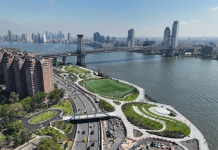
Community Board 3’s leaders have decided to go ahead with a vote next month on a set of guidelines for the Seward Park redevelopment site, more commonly known as SPURA. In a memo to board members posted online, CB3 Chair Dominic Pisciotta wrote, the land use, zoning and housing committee is “very close to finalizing discussions and hopefully reaching an agreement on (SPURA).”
(See Pisciotta’s letter here: warning PDF!).
He urged community board members, as well as members of the public, to familiarize themselves with the latest version of the guidelines. Referring to the January 24th committee meeting, Pisciotta added, “this may be the last discussion before a vote is taken.” Comments are being accepted via email until the end of the day on January 11th. If you would like a hard copy of the draft guidelines, give CB3 a call at 212-533-5300.
The current draft incorporates some of the feedback from this month’s SPURA meeting. The big issue to be resolved: how much affordable housing will be included in the project. Right now, the draft calls for 50% market rate, 20% moderate/middle income, 20% low income and 10% senior housing.
This month, Damaris Reyes, executive director of the affordable housing organization GOLES, said she was uncomfortable going ahead with a January vote, but she did not categorically rule out voting for the proposal. On the other extreme, Joel Kaplan of the United Jewish Council of the East Side told the New York Times he could accept 20% low income housing. He did not indicate whether the levels of middle/moderate and senior housing were acceptable.
If you would like to comment on the draft guidelines, send an email to spura@cb3manhattan.org. After the jump, you can view the full text, or download a PDF document from CB3’s web site.
DRAFT 3 DOCUMENT
Potential guidelines on program specifics for Seward Park sites redevelopment
Manhattanʼs CB3 Land Use, Zoning, Public & Private Housing Committee
December 16, 2010
For more information, please contact:
Community Board 3, Manhattan
59 East 4th Street
New York, NY 10003
Phone: 212-533-5300
Fax: 212-533-3659
E-Mail: spura@cb3manhattan.org
Potential CB3 Guidelines for Seward Park Sites Redevelopment
Presented below are recommended guidelines for consideration by Manhattanʼs Community Board 3 (CB 3). The CB 3 Land Use, Zoning, Public & Private Housing Committee prepared these guidelines. They are intended to guide the City of New York in its preparation of a plan and subsequent Request for Proposals (RFP) to develop the Seward Park sites. Submit
comments to spura@cb3manhattan.org by 5:00 P.M. January 11, 2011.
I. INTRODUCTION
A. Guiding Principles
1) The plan and subsequent RFP for the Seward Park Sites must be in accordance with the principles laid out herein. Maximization of City revenue from the sale of the land should be a secondary consideration.
2) The City should select multiple developers, with additional consideration given to Lower East Side and/or other local non-profit developers. The cumulative effect of their proposals and subsequent actions must result in a development that adheres to these guidelines and underlying principles.
3) The Cityʼs conveyance of the land should include binding restrictions to assure that these principles are achieved.
B. Community Oversight
1) The City must communicate regularly with CB 3 on all aspects of project development, from preparation of the RFP and the Uniform Land use Review Procedure (ULURP) process through completion of all associated planning, programming and development.
2) There must be robust community participation in the planning and review process for the sites. This includes open information and regularly scheduled public meetings distinct from public hearings.
II. LAND USE AND PROGRAM
A. Mixed-Use Development
1) The mixed-use, mixed-income character of the neighborhood must be reflected in the development plan for the sites.
2) Each phase of development must reflect the mixed-use, mixed-income guidelines indicated herein, except if federal regulations require senior housing to be separated from other uses and thus built as an independent phase or project element.
B. Commercial Development
1) Full opportunity should be provided for economic development and local employment and entrepreneurship. All employment opportunities should offer wages that take into consideration the cost of living in New York City, rather than the statewide minimum wage.
2) Retail should be maximized in street-level building frontages along major streets (i.e., Delancey Street west of Clinton Street and Essex Street).
3) Local service and convenience retail uses should predominate in street-level building frontages along side streets (i.e., Broome Street, Grand Street, Ludlow Street, Norfolk Street and/or Suffolk Street).
4) Mid-box retail should be encouraged to locate predominantly on the second floors of buildings along major streets (i.e., Delancey Street and/or Essex Street). “Mid-box” retail is defined as stores equal to 10,000 to 30,000 square feet (sf).
5) With the exception of a possible supermarket, no single retail tenant should exceed 30,000 sf in size. In addition, no more than three new liquor licenses within 500 feet of each other should be issued to establishments on the side streets, and no licenses can be established within 200 feet of any school or religious institution.
6) If the existing Essex Street Market is to be relocated, it should be moved to a superior site on a major street to accommodate a larger market with more goods and services. The existing Essex Street Market should not be closed or demolished before the new, larger market is open. Every effort (such as special consideration as to rents) should be made to retain the then current tenants of the Essex Street Market during the change in location and facility.
7) Every phase of retail development must provide a diversity of goods, services and price points.
8) Non-retail, commercial development – including office, hotel and/or a movie theater – should be provided. A movie theater is a priority; this use could be a component of a multi-purpose performance space, including one in connection with civic uses (see #2.D). The final commercial uses and their floor areas will depend on market conditions at the time of development, as well as satisfactory proposals by development or operating entities.
C. Housing
1) The sites should be developed to optimize their aggregate residential potential. At least 800 and preferably more than 1,000 housing units must be provided. (This range should be refined following community engagement in connection with
anticipated urban design analyses for the site.) However, the overall housing component should not comprise less than 60 percent of the total floor area of all sites, excluding floor area devoted to below-grade parking.
2) The mixed-income character of the neighborhood must be reflected in the development plan for the sites. Accordingly:
a. Approximately 50 percent of all units should be available at market-rate values (i.e., for households with no income restrictions).
b. Approximately 10 percent of all units must be reserved for middle-income households.
c. Approximately 10 percent of all units must be reserved for moderate-income households.
d. Approximately 20 percent of all units must be reserved for low-income households.
e. Approximately 10 percent of all units must be reserved for seniors. Supportive housing for low-income individuals and/or families is permitted under this and the above allocation (see #II.C.3.c).
f. The household income definitions are as follows:
g. Units should be affordable to a multitude of incomes within the above ranges (see #II.C.3.f), rather than to just the upper limits of each.
3) Every effort should be made to secure Federal, State and other outside funding to achieve the quantities of non-market-rate housing aspired to above. The ability of respondent developers to maximize the number of non-market-rate units should be a major criterion of the RFP and in the selection of developers.
4) To the extent possible, developers should be encouraged to consider homeownership and variant models (such as mutual housing).
5) In mixed-income buildings, the non-market-rate units should be integrated with the market-rate housing and be indistinguishable from the exterior in terms of material and design quality. Further, the non-market-rate component should have at least the same proportion of two- and three-bedroom apartments as the market-rate component; however, in all cases, at least 40 percent of all non-market-rate units should be two-bedrooms or larger. All non-market-rate units must comply with the NYC Department of Housing Preservation and Development (HPD) “Design Guidelines for New Construction,” which includes standards for unit size and layout.
6) The non-market-rate housing units should be prioritized for qualifying residents of Community District 3, residents who may be relocated as a result of planned development, and Tenants at Title Vesting – the former site tenants.
7) All non-market-rate units must remain affordable in perpetuity.
D. Civic Uses
1) The site development must include community, cultural and/or institutional (“civic”) uses and amenities that benefit residents of all ages.
2) Full opportunity should be provided for civic uses and amenities. It is understood that such use(s) for each site will depend on project feasibility as well as a satisfactory proposal by a development or operating entity. Civic use is broadly defined to include a possible non- or limited-profit retail component and/or non-profit offices.
3) The civic use obligation may in large measure but not entirely be satisfied by any one such use.
4) Sufficient land and building capacity should be set aside for a public primary or secondary school. Ideally, students from both School Districts 1 and 2 should be allowed to attend the school, regardless of which district it is ultimately located in.
The siting of the school should allow it to be oriented to a side street.
5) Parks and open space should be a major feature of the final development program. A side street orientation is preferred for local neighborhood open space, such as a playground.
6) Every effort should be made to include a non- or limited-profit retail or other commercial component in the final program. This use may substitute for either local service and convenience retail (see #II.B.3). It is understood that this use will depend
on project feasibility as well as a satisfactory proposal by a development or operating
entity.
III. SITE LAYOUT AND DEVELOPMENT
A. Site-Specific Concerns
If necessary, as a development plan approaches and enters the ULURP process, site-
specific concerns (e.g., regarding program mix, affordability, urban design or other
aspects) that arise should continue to be addressed by members of the Community
Board, its designated committee and the City.
B. Commercial Overlay
The sites along Delancey Street and Grand Street should be rezoned to include a commercial overlay.
C. Urban Design
1) The final building and site plans must be in keeping with current planning principles of contextual design: e.g., building orientation and access should support and enhance the pedestrian realm and weave together the fabric of the neighborhood.
Their final designs should consider successful models that have been employed in other cities around the nation and the world, especially as they pertain to mixed-income and mixed-use developments.
2) Existing streets, including those that have been de-mapped, should be preserved.
3) The development should exemplify good urban design and sound environmental principles. Environmental design solutions, such as passive and active energy and water use efficiencies, should be promoted. The development should comply with Enterprise Green Communities certification, which has been adopted by HPD as the standard for its new projects.
D. Parking
The development should include at least enough public parking to replace the existing on-site public parking for cars (i.e., excluding commercial vehicles and trucks) that will be displaced as a result of development.










